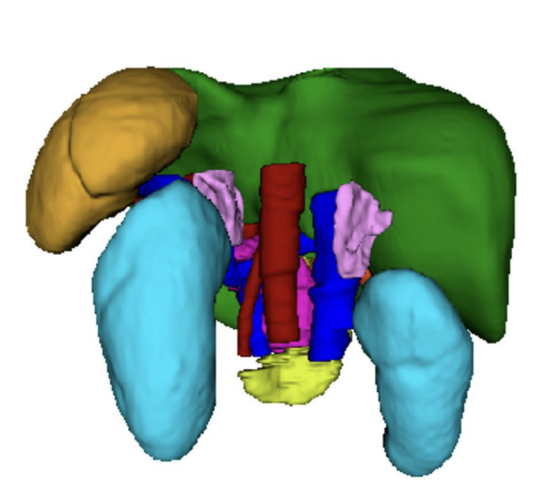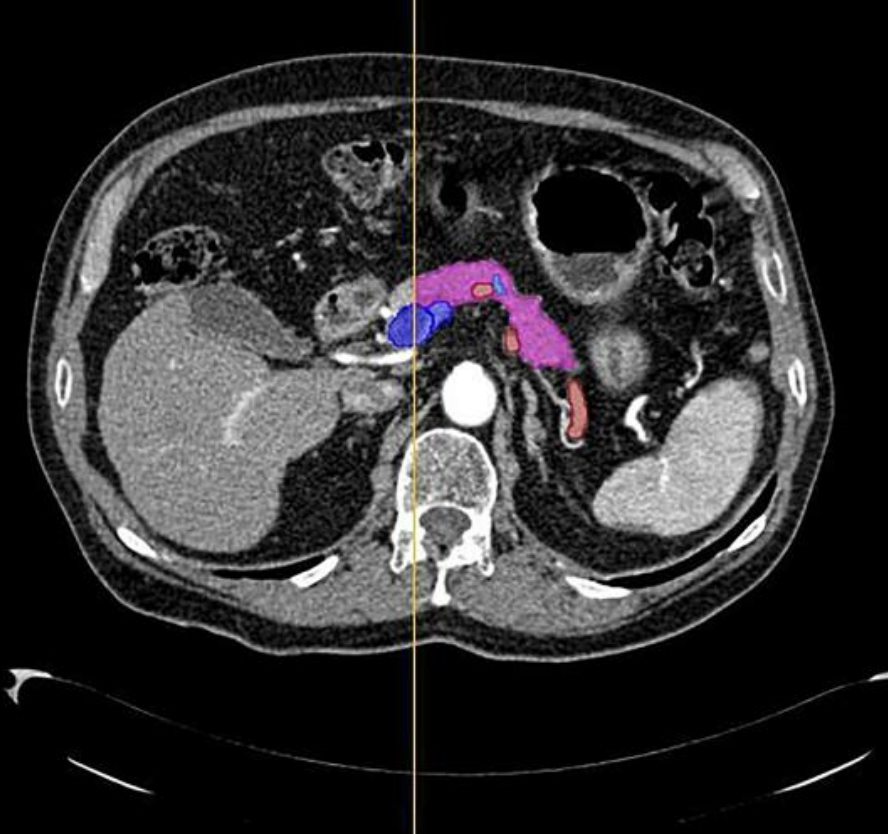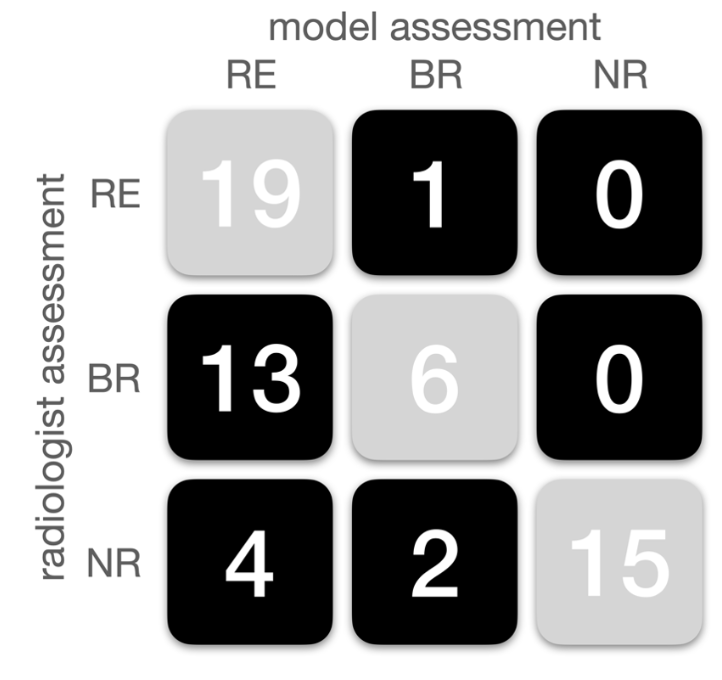publications
publications by categories in reversed chronological order. generated by jekyll-scholar.
2024
- Artificial intelligence for assessment of vascular involvement and tumor resectability on CT in patients with pancreatic cancerJacqueline I. Bereska, Boris V. Janssen, C. Yung Nio, Marnix P. M. Kop , and 8 more authorsEur Radiol Exp, Feb 2024
This study aimed to develop and evaluate an automatic model using artificial intelligence (AI) for quantifying vascular involvement and classifying tumor resectability stage in patients with pancreatic ductal adenocarcinoma (PDAC), primarily to support radiologists in referral centers. Resectability of PDAC is determined by the degree of vascular involvement on computed tomography scans (CTs), which is associated with considerable inter-observer variability.
@article{bereska_artificial_2024, title = {Artificial intelligence for assessment of vascular involvement and tumor resectability on CT in patients with pancreatic cancer}, author = {Bereska, Jacqueline I. and Janssen, Boris V. and Nio, C. Yung and Kop, Marnix P. M. and Kazemier, Geert and Busch, Olivier R. and Struik, Femke and Marquering, Henk A. and Stoker, Jaap and Besselink, Marc G. and Verpalen, Inez M. and {for the Pancreatobiliary and Hepatic Artificial Intelligence Research (PHAIR) consortium}}, year = {2024}, month = feb, journal = {Eur Radiol Exp}, volume = {8}, number = {1}, pages = {18}, issn = {2509-9280}, doi = {10.1186/s41747-023-00419-9}, urldate = {2024-08-22}, language = {en}, }
2023
- Radiomics preoperative-Fistula Risk Score (RAD-FRS) for pancreatoduodenectomy: development and external validationErik W Ingwersen, Jacqueline I Bereska, Alberto Balduzzi, Boris V Janssen , and 14 more authorsBJS Open, Oct 2023
Accurately predicting the risk of clinically relevant postoperative pancreatic fistula after pancreatoduodenectomy before surgery may assist surgeons in making more informed treatment decisions and improved patient counselling. The aim was to evaluate the predictive accuracy of a radiomics-based preoperative-Fistula Risk Score (RAD-FRS) for clinically relevant postoperative pancreatic fistula.Radiomic features were derived from preoperative CT scans from adult patients after pancreatoduodenectomy at a single centre in the Netherlands (Amsterdam, 2013–2018) to develop the radiomics-based preoperative-Fistula Risk Score. Extracted radiomic features were analysed with four machine learning classifiers. The model was externally validated in a single centre in Italy (Verona, 2020–2021). The radiomics-based preoperative-Fistula Risk Score was compared with the Fistula Risk Score and the updated alternative Fistula Risk Score.Overall, 359 patients underwent a pancreatoduodenectomy, of whom 89 (25 per cent) developed a clinically relevant postoperative pancreatic fistula. The radiomics-based preoperative-Fistula Risk Score model was developed using CT scans of 118 patients, of which three radiomic features were included in the random forest model, and externally validated in 57 patients. The model performed well with an area under the curve of 0.90 (95 per cent c.i. 0.71 to 0.99) and 0.81 (95 per cent c.i. 0.69 to 0.92) in the Amsterdam test set and Verona data set respectively. The radiomics-based preoperative-Fistula Risk Score performed similarly to the Fistula Risk Score (area under the curve 0.79) and updated alternative Fistula Risk Score (area under the curve 0.79).The radiomics-based preoperative-Fistula Risk Score, which uses only preoperative CT features, is a new and promising radiomics-based score that has the potential to be integrated with hospital CT report systems and improve patient counselling before surgery. The model with underlying code is readily available via www.pancreascalculator.com and www.github.com/PHAIR-Consortium/POPF-predictor.
@article{ingwersen_radiomics_2023, title = {Radiomics preoperative-Fistula Risk Score (RAD-FRS) for pancreatoduodenectomy: development and external validation}, shorttitle = {Radiomics preoperative-Fistula Risk Score (RAD-FRS) for pancreatoduodenectomy}, author = {Ingwersen, Erik W and Bereska, Jacqueline I and Balduzzi, Alberto and Janssen, Boris V and Besselink, Marc G and Kazemier, Geert and Marchegiani, Giovanni and Malleo, Giuseppe and Marquering, Henk A and Nio, C Yung and {de Robertis}, Riccardo and Salvia, Roberto and Steyerberg, Ewout W and Stoker, Jaap and Struik, Femke and Verpalen, Inez M and Daams, Freek and {for the Pancreatobiliary and Hepatic Artificial Intelligence Research (PHAIR) consortium}}, year = {2023}, month = oct, journal = {BJS Open}, volume = {7}, number = {5}, pages = {zrad100}, issn = {2474-9842}, doi = {10.1093/bjsopen/zrad100}, urldate = {2024-08-22}, } - Improving the Reliability of Medical Diagnostic Models through Rule-Based Decision DeferralJacqueline Isabel Bereska, Henk Marquering, Marc Besselink, Jaap Stoker , and 1 more authorProceedings of the AAAI Symposium Series, Oct 2023
Pancreatic ductal adenocarcinoma (PDAC) is a highly lethal cancer, and accurate assessment of tumor resectability is crucial for determining appropriate treatment. AI-based models have shown promise in classifying tumor resectability, but reliability concerns have impeded clinical implementation. We propose extending the AI-based VasQNet model for classifying tumor resectability on AI-generated segmentations of computed tomography scans (CTs) to improve the models’ reliability. This extension allows VasQNet to defer decisions when the AI-generated segmentations violate pre-established rules on vascular anatomy, tumor location, and tumor size. We conducted experiments using CTs of (borderline) resectable and non-resectable PDAC patients. We evaluated the performance of the baseline VasQNet and the extended VasQNet with rule-based decision deferral (RBDD) by comparing their classifications to a ground-truth provided by a radiologist, employing agreement as a metric. Our results demonstrate that the extended VasQNet achieved a significantly higher agreement (90%) with the radiologist’s classification than the baseline VasQNet (67%). Notably, 17/31 (54%) deferred decisions would have been incorrect had they not been deferred. Our study demonstrates the effectiveness of RBDD in improving the reliability of clinical diagnostic models through the exemplification of VasQNet. In conclusion, RBDD can enhance the reliability of clinical diagnostics models, facilitating integration into clinical practice. The documented code is available on GitHub (https://github.com/PHAIR-Consortium/Vessel-Involvement-Quantifier).
@article{bereska_improving_2023, title = {Improving the Reliability of Medical Diagnostic Models through Rule-Based Decision Deferral}, author = {Bereska, Jacqueline Isabel and Marquering, Henk and Besselink, Marc and Stoker, Jaap and Verpalen, Inez}, year = {2023}, month = oct, journal = {Proceedings of the AAAI Symposium Series}, volume = {1}, number = {1}, pages = {122--126}, issn = {2994-4317}, doi = {10.1609/aaaiss.v1i1.27488}, urldate = {2024-08-22}, copyright = {Copyright (c) 2023 Association for the Advancement of Artificial Intelligence}, language = {en}, }


